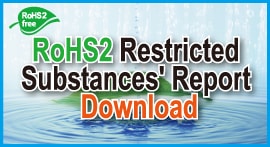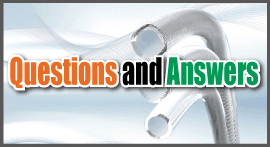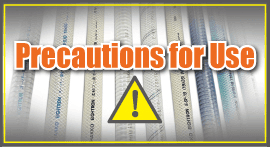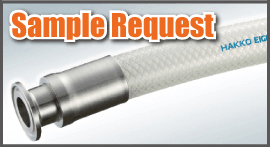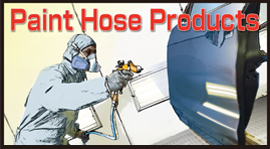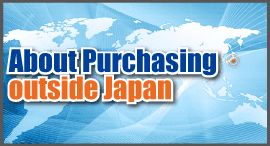Information on Food Sanitation Law Revision
"The Partial Revision of the Food Sanitation Act" was promulgated on June 13, 2018. It was taken effect on June 1, 2020. HAKKO CORPORATION manages and responds in accordance with the new Food Sanitation Law.
This web-page provides useful information on the revised Food Sanitation Act regarding plastic hoses and tubes.
*Please note that this web-page is based on information as of June 2020.
There is a five-year transitional period (from June 1, 2020 to May 31, 2025). During this transitional period, food and beverage hoses/tubes that are compliant in the Food Sanitation Law No.370 are still allowed to use.
HAKKO CORPORATION is currently preparing for a document (Self-Declaration Form) to provide information in accordance with the Positive List System. If you have any questions or requests, please contact us from here.
Reference: Ministry of Health, Labour and Welfare website "Revision of the Food Sanitation Law."
1. Background and Purpose of this Revision (From The Ministry of Health, Labour and Welfare Website)
About 15 years have passed since the previous revision of the Food Sanitation Act, despite the changes in household structures and in the environments surrounding food (such as increasing demand of prepared food, eating out and snacks as well as progress in food globalization such as increasing imported food).
It is an urgent matter to deal with health issues caused by food (such as the occurrence of food poisoning in a wide area all over the Japan).
Also, considering the 2020 Tokyo Olympic and Paralympic Games and the promotion of food exports, food sanitation managements that are consistent with international standards is now required.
2. Outline of the Revision
The Ministry of Health, Labour and Welfare presents the following seven revisions.
The two revisions that are particularly relevant to hose and tubing are "2. Systematization of Health Management in line with HACCP" and "4. Development of internationally consistent sanitary Regulations for Food Utensils, Containers and Packaging."
1. Reinforcement of Measures against Food Poisoning over a Wide Area
2. Systematization of Health Management in line with HACCP
3. Collection of Information on Health Hazards caused by Foods containing Ingredients requiring Special Attention
4. Development of internationally Consistent Sanitary Regulations for Food Utensils, Containers and Packaging
5. Review of the Business Licensing System and Establishment of a Business Notification System
6. Establishment of a Reporting System for Food Recall Information
7. Others (Establishment of Import Requirements such as the Attachment of Health Certificates for Dairy Products and Fishery Foods and Establishment of Regulations concerning Food Export-related Affairs by Local Governments)
3. Points for Hose and Tube
Systematization of Health Management in line with HACCP
What is the Outline?
All food business operators (manufacturer, processing, cooking and sales of food products) will prepare sanitation management plans, based on A and B below. *Certification is not required under the current system.
(A) Hygiene Management based on HACCP
Based on the seven principles of HACCP, food business company prepares and manages plans, according to the raw materials and manufacturing methods.
[Target Entities]
(a) Consider the Scale of the Entities
(b) Slaughterhouses [Slaughterhouse Operators, Slaughterhouse Managers and Slaughterhouses]
(c) Edible Bird Treatment Plant [Bird Processors (Excluding Certified Small-Scale Poultry Processors)]
(B) Sanitation Management incorporating the Concepts of HACCP
Conduct hygiene management using a simplified approach with reference to manuals prepared by industry associations.
[Target Entities]
(a) Small Businesses (*Based on the number of employees at each business site, we will listen to the opinions of relevant parties and consider in the future.)
(b) Manufacturers, processors and cookers whose sole purpose is retail sales at the store (Examples: manufacturer and sale of sweets, sale of meat, sale of seafood, manufacturer and sale of tofu.)
(c) Industries that provide a large variety of food products and frequently change their products (Examples: Restaurants, food service facilities, production of dishes, production of bentos, etc.)
(d) Industries which can be controlled by general sanitation management (Example: sales of packaged foods, food storage and food transport)
(C) Measures for Export to EU and USA (HACCP + α)
In addition to sanitation management based on HACCP, facilities criteria and additional requirements (Implementation of Microorganism Tests and Monitoring of Residual Animal Drugs, etc.) required by importing countries must be met.
What's our schedule? By when do we need to respond?
Effective as of June 1, 2020
(*There is a one-year transitional period. Full-Scale implementation from June 1, 2021)
What exactly do we need?
Hygiene management based on HACCP standards is now required. Food grade hoses also need to be improved in terms of washability, prevention of contamination and other aspects of hygiene management. However, as stated in the "Certification is not required under the current system," it is not necessary to obtain certification.
Development of internationally consistent Sanitary Regulations for Food Utensils and Containers and Packaging (Introduction of a Positive List System)
What is an Outline?
The standards for containers and packaging include (1) general standards applicable to all materials (2) standards applicable to each material (3) classifying standards by use requiring safety consideration and (4) manufacturing standards. A positive list system that allows the use of only substances whose safety has been evaluated in the case of plastic containers and packaging has been introduced.
*Positive List ... May be abbreviated as "PL"
Previous System
Negative List System
List substances whose use is restricted in principle after allowing their use
In Japan, highly toxic substances (such as heavy metals) are regulated by dissolution tests.
Current System (Effective on June 1, 2020)
Positive List System
In principle, the use of substances is prohibited, and the substances permitted to be used are listed.
There is a list of substances approved for use as base polymers and additives of synthetic resins in direct contact with food. The use of these substances is usually prohibited, and the substances permitted to be used are specified. Only safe substances which are assured can be used.
A current system is based on voluntary standards (Positive List of Approximately 1,500 Chemical Substances and Hygiene Test Methods).
What exactly do you need?
Use of Materials and Substances in the Positive List
Plastic hoses and tubes that come into contact with food and packaging are subject to comply with the positive list system.


